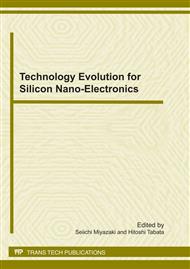p.43
p.48
p.54
p.60
p.66
p.72
p.79
p.85
p.92
Nanosize Electronics Material Analysis by Local Quantities Based on the Rigged QED Theory
Abstract:
In this article, we propose two analysis method using novel local quantities. One method is related to the dynamics of electron spin. This is described by novel quantities, the spin torque and the zeta force. These quantities govern the dynamics of the spin of electrons, and hence can clarify the essential description of the dynamics of electron spin. The other method is related to the conductivity of nanosize materials. For this method, we introduce external and internal local conductivities. A microscopic viewpoint is important for the analysis of nanosize material. As a first step, we show the validity and usefulness of our methods. The zeta force clarifies how the local torque works on the electron spin in molecules. The external and internal local conductivities show how electrons pass through nanosize materials and how electrons are locally accelerated in the materials.
Info:
Periodical:
Pages:
66-71
Citation:
Online since:
February 2011
Authors:
Price:
Сopyright:
© 2011 Trans Tech Publications Ltd. All Rights Reserved
Share:
Citation:


